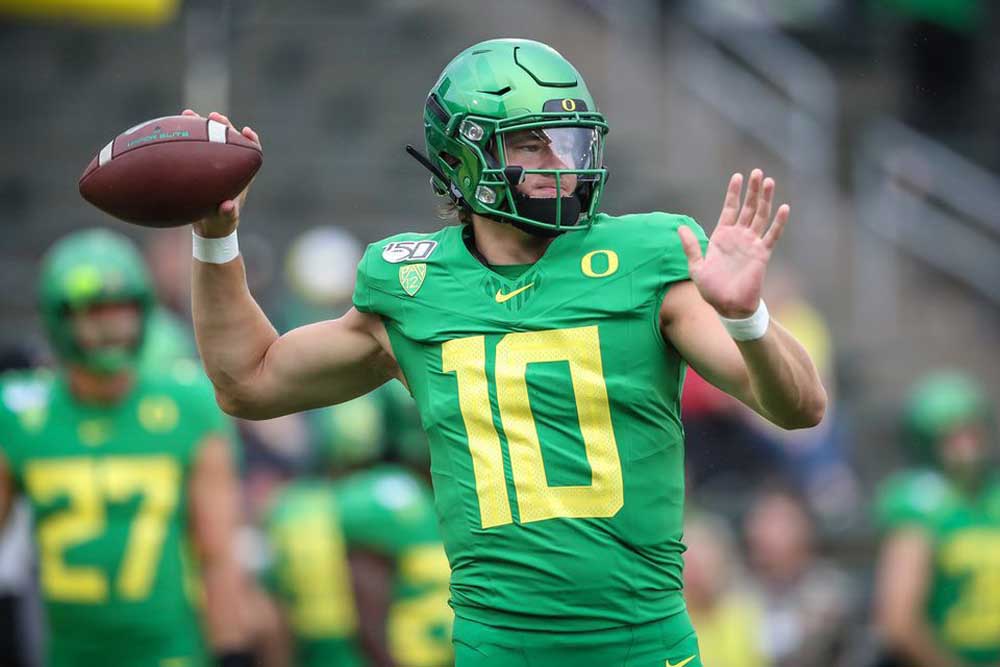Canzano: If the NFL has learned anything — Justin Herbert to the Chargers feels about right
Published 10:00 pm Sunday, April 19, 2020

- Oregon's Justin Herbert threw 32 touchdown passes last season.
People keep asking me if I think Justin Herbert has what it takes between the ears to become a good NFL quarterback.
I keep wondering, have they ever talked with him?
Others question his quiet leadership.
I wonder, how much did they watch him?
Others yet, announce definitively he’ll be a bust.
I wonder, who do they think they’re fooling?
Oregon’s Herbert has become a lightning rod in this draft. The latest projections have him going to either the Dolphins at No. 5 or Chargers at No. 6. I vote Chargers. There’s a huge difference in my mind. Because I’m reminded as the draft approaches of a conversation I once had with the late Bill Walsh.
Walsh wasn’t a fan of struggling franchises drafting quarterbacks high in the first round at all. Our talk came in the summer of 2002, as he’d been relegated to the role of “advisor” in the 49ers organization. I visited him in his office, and Walsh pointed out that the prevailing top passers in the AFC and NFC were an indictment of the league’s general managers.
Kurt Warner, with the St. Louis Rams, finished the 2001 season as the highest-rated passer in either conference. He was 30 years old. Warner was undrafted out of college and had come to the league a free agent through the Arena Football League.
Rich Gannon, 36 and with the Oakland Raiders, was a fourth-round draft pick in 1987 who didn’t start an NFL game until the fourth game of his fourth season in the league. He was rated No. 2-rated overall in 2001 and the top quarterback in the AFC.
Jeff Garcia, then with the 49ers and age 31, presented another strong case. Garcia went undrafted out of college. A lack of arm strength and size were his biggest pre-draft criticisms. Garcia spent four seasons in the CFL before signing as a free agent with the 49ers. He ended up the No. 3-rated passer in the 2001 season.
“There’s just overwhelming evidence out there,” Walsh said, “so why do the GMs and owners ignore it?”
He knew the answer. The league’s general managers needed to win games right away — or at least avoid being fired. They were drafting high with a lot of pressure, but more significantly, most didn’t have the job security to be able to take a counter-culture stance on draft day.
Earlier that spring, Walsh watched the Houston Texans use the NFL Draft to take Fresno State’s David Carr with the No. 1 overall pick. Matt Millen, the GM in Detroit, had no previous experience as a franchise CEO and personnel manager. The Lions picked Oregon’s Joey Harrington at No. 3.
Walsh suspected that both quarterbacks might thrive in the right system with time to mature and grow. After all, that time and patience had paid dividends with Warner, Gannon and Garcia.
But we all know what happened.
In 2002, Carr was No. 31 in the league in passer rating (62.8). Harrington was No. 32 (59.9). Carr did manage to set one league record — most times sacked (76). But between them, they went a combined 7-21 as starters that first season. It was a living hell for them, and they were eventually scapegoated by their respective franchises.
Busts? Or more likely, victims of circumstance?
More questions:
Does Herbert have the physical tools? Sure. He’s big, tall and strong. He has a terrific arm, better than advertised feet, and there were occasions in his time at Oregon where he made brilliant throws and good decisions. But I never did see complete football games where I left in awe of his ability. It was more about him performing consistently well with what he had to work with.
Does Herbert have the brain? Absolutely. Anyone who has ever talked with him knows he’s intelligent, studious and thoughtful. He was a Biology major with a 4.0 grade-point average. His Wonderlic score: 39. Higher than LSU’s Joe Burrow (34) or Alabama’s Tua Tagovailoa (19) and second-best among all quarterbacks in this draft.
Does he have the leadership gene? Probably. I think. Maybe. I didn’t see Herbert as much of an outspoken and vocal leader on the field during games. Then again, some quarterbacks are inwardly focused and still obviously hyper-competitive. I’m not sure a quarterback needs to be as demonstrative on the field as he just needs to be effective and make good decisions.
To that point, I think one of the most glaring weaknesses I’ve seen in Herbert’s public assessments from draft experts is how easily and quickly they overlook the landscape of Herbert’s time in Eugene.
Herbert played for three head coaches in four seasons — Mark Helfrich, Willie Taggart and Mario Cristobal. He also was injured for part of one season (broken collarbone). In that span of disruption, Herbert threw 95 touchdown passes against 23 interceptions. He completed 64 percent of his passes and his rating never dropped below 144.6 for any season.
Helfrich got fired after Herbert’s freshman season. Taggart came in, then bolted after one season. Cristobal took over. Three different coaches. Three distinct identities in charge. Chaos ruled. It was organizational whiplash. Nobody quite knew what was going to happen with the program. But all Herbert did amid that was play consistently well, and without him in uniform both Helfrich and Taggart struggled mightily.
Think about that last part.
Those coaches needed Herbert to win.
Herbert’s final season is interesting to me. Because I spent much of it lamenting how the play calling by offensive coordinator Marcus Arroyo stood in Herbert’s way. It was evident that Oregon wanted to run the ball behind the eventual Outland Trophy winner, left tackle Penei Sewell. The Ducks did very little to get their star quarterback comfortable and in rhythm early in games. He wasn’t the focal point of the offense. Also, Herbert had very little to work with receiver-wise.
When tight end Jacob Breeland, easily Herber’s favorite target, was lost for the season, it was decided. The Ducks would run the ball. Herbert was left throwing to a marginal group of playmakers at receiver. It became difficult to watch sometimes. But amid that Herbert threw 32 touchdowns and only six interceptions and finished the season by completing 66.8 percent of his passes.
Will Herbert be a bust?
I’ve talked publicly and privately with NFL scouts, current and former players, and the pundits who do mock drafts. Everyone agrees that Herbert has the size and arm. But they’re split on whether he’ll truly succeed at the next level — for a variety of reasons. Still, I keep coming back to that conversation with Walsh all those years ago.
He knew the quarterback was only a small part of that equation. Walsh understood that desperately drafting a quarterback, putting him on the field right away, and hoping for the best often ended in disaster. Walsh pointed out that the general managers drafting near the end of the first round had inherent advantages.
Those GMs could afford to be wrong and not get fired.
Those executives could conceivably pass on a quarterback high in this 2020 draft without fear of losing the job. Also, they don’t need immediate help. It’s why Walsh believed the GMs at the front of the draft probably leaned more on the “measureable” data derived from the NFL combine vs. what their eyes told them in scouting. That data helps justify the picks. Those GMs don’t need to be right as much as they need the picks to be bulletproof.
I think Herbert has a chance to be a good player at the next level. Just like Burrow and Tagovailoa, too. They’ll be thrown into a paint shaker as rookies, and blamed in the end if the loser franchises that draft them keep right on losing. I wonder sometimes if we could re-draft them years later and get dramatically different results.
In 2000, Cleveland held the No. 1 pick in the draft and took defensive lineman Courtney Brown. If we re-drafted using a time machine today, the Browns would instead pick Tom Brady, Michigan. It’s the no-brainer pick. He wouldn’t have lasted until Round 6, where the Patriots selected him and sat him behind Drew Bledsoe.
So would Brady still be Brady? Or would Brady have been… a bust? Discuss.
I keep thinking about Gannon, Garcia and Warner in 2001 and wondering why most NFL teams have been slow to study their own history. Examine Oregon State’s Jake Luton through that prism. Tall. Strong arm. Likely a fifth-round pick or so. If he gets with a franchise willing to be patient, let him develop and mature, I could see Luton having a nice NFL career.
Herbert to the Chargers at No. 6 overall — I like. Just not for the reasons most think. The Chargers need their quarterback of the future, but they also trust veteran Tyrod Taylor. Taylor, not Herbert, would be the starter next season under the ideal scenario. Herbert could sit some as a rookie, pressure off, grow into the job and not become another early-draft casualty.
I’m sure of one thing — if Herbert goes to a franchise in this draft that changes coaches multiple times, and fosters chaos around him, he’ll be right at home.
He’s pretty much done that already in college.






